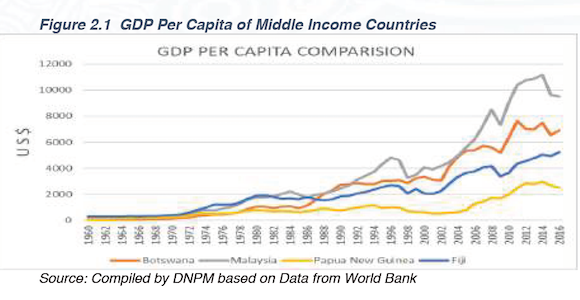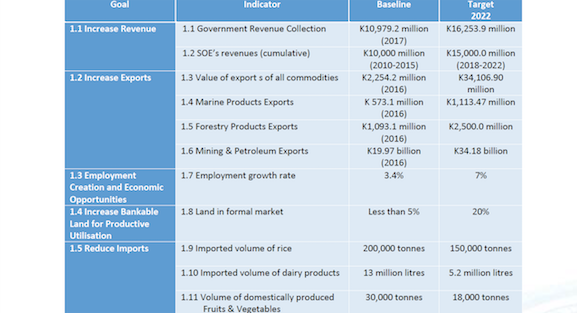The Papua New Guinea Government is planning to sharply increase its economic stimulus, according to its newly-released Medium Term Development Plan III, 2018–2022. It envisions a ‘strategic shift’ in Budget allocations that will see more than a doubling of expenditure on ‘economic growth areas.’

Papua New Guinea’s GDP per head (yellow) has lagged other middle income countries. Source: MDTP, World Bank
The plan, which was released late last month by the Department of National Planning and Monitoring, suggests that the austerity that the PNG Government has observed over the last three years may be replaced with a more stimulatory package.
‘Government revenue collection is forecast to increase from K10.98 billion in 2017 to K16.25 billion in 2022’
‘The economic sector will be given prominence in the medium term,’ the plan indicates.
The MTDP says the ‘share of investments’ by government that is directed at ‘economic growth areas’ will increase dramatically from ‘the current 5 per cent of the total capital expenditure to 12 per cent’ in the next five years.
The MTDP also outlines a plan to improve the government’s revenue collection.
‘Revenue shortfalls is one of the critical factors contributing to mixed results and poor development outcomes,’ it argues.
Government revenue collection is forecast to increase from K10.98 billion in 2017 to K16.25 billion in 2022, a rise of 48 per cent.
Targets
Other targets for 2022 are:
- State-owned enterprise revenues to increase from K10 billion to K15 billion.
- The annual employment growth rate to increase from 3.4 per cent to 7 per cent.
- More bankable land available for productive use: from less than 5 per cent now to 20 per cent
‘The trend over the years is that expenditure is higher than the revenue.
‘Only by increasing internal revenue, will the Government be able to adequately meet the demands of the increasing population.’
The report says in the past the focus was on ‘spending without increasing the revenue from which to finance development interventions.’

The government’s 2022 targets. Source: MDTP
Coordination
The MDTP says there is a need to improve coordination within the government and other agencies and create a ‘whole of government’ approach.
‘Experience indicates that activities across all levels are uncoordinated, resulting in serious incoherencies at different levels of implementation.
‘Ineffective collaboration and coordination of agencies within sectors and among stakeholders has resulted in duplications and parallel service delivery systems. There is a lack of effective partnership between national agencies and the private sector to achieve maximum returns to the economy and the country as a whole.
‘A whole of government approach with development partners and key stakeholders such as churches, is required to streamline all development activities to achieve the economies of scale needed.’
‘PNG’s economic base is still fragile despite efforts made to improve the business environment and promote private sector investment in the non-resource sectors.’
The MTDP questions the current allocation of resources, especially ‘capital investment funding to growth areas’.
‘The lack of clear guidelines has resulted in inefficient distribution of resources to different sectors and agencies, thus leading to ineffective implementation and achievement of development outcomes.’
Priorities
The MTDP also points to a lack of accurate and reliable data, saying that information and statistical systems are ‘lacked integration, with each agency independently managing their own database system’.
It says that this makes it difficult to assess the state of national development outcomes.
‘The past development plans of various sectors, agencies and sub-national governments, lacked alignment with the national development plans.
‘This resulted in disconnect and fragmentation between different sectors and levels of government, which led to wastage and misdirected the government priorities.’
PNG’s economic base is ‘still fragile despite efforts made to improve the business environment and promote private sector investment in the non-resource sectors’ the MTDP says.
‘Commercial goods production is not fully developed and diversified, and current production is still limited and sensitive to external factors, such as goods price changes and international competition.
‘The gap between the rich and the poor is still large.’








Speak Your Mind